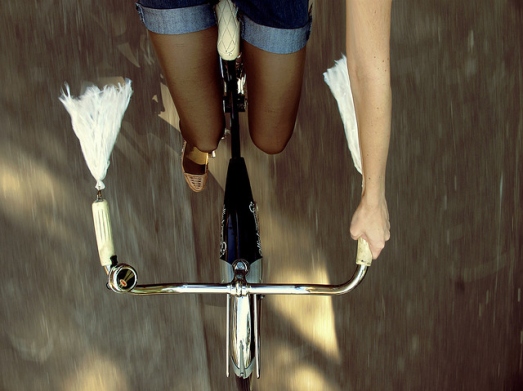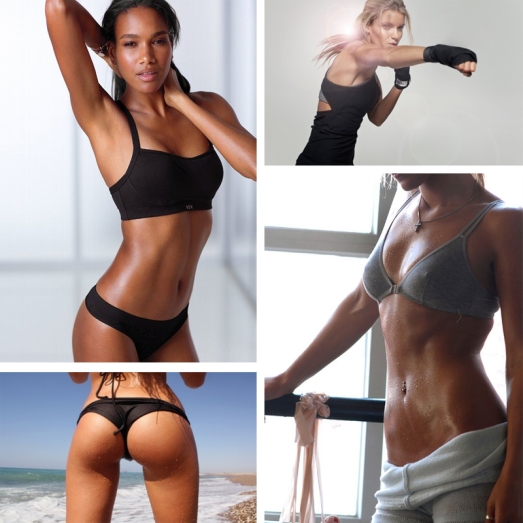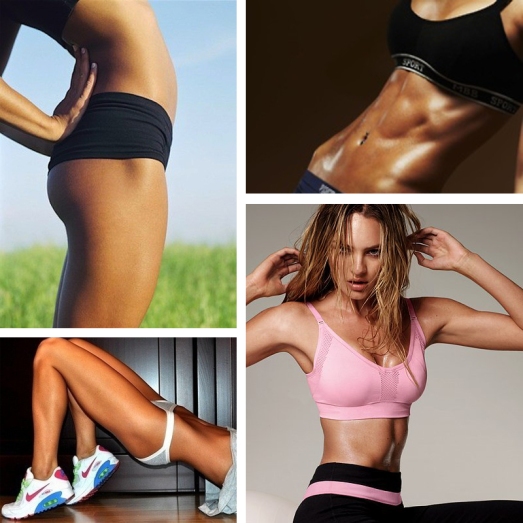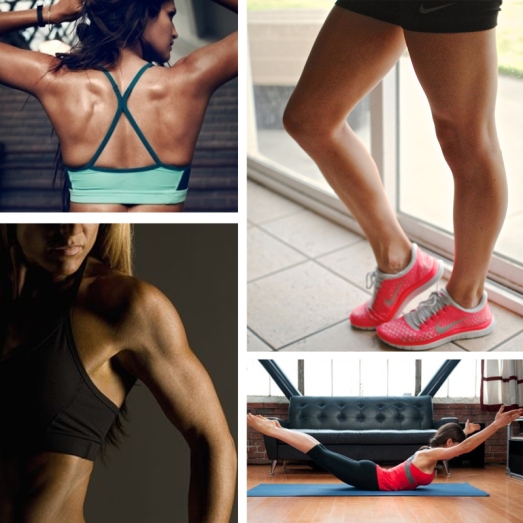Tag Archives: fitness
Get Your Body Back After Pregnancy
Dedication and patience are key to losing postpartum baby weight and looking like your pre-baby self again.

If all those images of svelte and shapely celebrity new moms have left you feeling like you never want to look in a mirror again, take heart! Here’s some real-world advice on how to get your body back after pregnancy.
With so many high-profile celebrity moms snapping back from pregnancy with a model-perfect shape in almost no time, it sometimes seems as if they’re jumping right from the labor bed to the treadmill. Take a look, for instance, at Katie Holmes, Angelina Jolie, Melania Trump, Heidi Klum, and former Spice Girl Victoria Beckham — whose record-time baby-fat weight loss has set the bar high for new moms the world over.
But is it realistic — or for that matter even healthy — to slim down after pregnancy with such lightening speed?
Experts offer up a resounding “No!”
“We don’t have the kind of lifestyle that would allow for that kind of quick loss — and the sooner women recognize that, the better they will feel about themselves, ” says Laura Riley, MD, a high-risk-pregnancy expert from Massachusetts General Hospital and spokeswoman for the American College of Obstetricians and Gynecologists.

Riley says celebrities don’t generally gain as much weight during their pregnancy as the average woman, and, she says, “they have resources that the rest of us don’t have after baby is born.” This includes personal trainers, chefs, and nannies, all of whom allow the celebrity new mom to devote serious time to getting in shape.
“And, many of them also do crazy diets — which is not an example anyone should follow,” says Riley, author of You and Your Baby: Pregnancy.

Experts warn that when it comes to getting that post-pregnancy body back in shape, neither crash dieting nor a stringent exercise program is the way to go — particularly if you’ve had a difficult pregnancy or a C-section delivery or are breastfeeding.
“The worst thing a woman can do is try too hard to do too much too soon — if you do, you’re likely to find yourself exhausted and discouraged and less likely to continue, and you’ll wind up carrying that baby weight a lot longer, ” says fitness trainer Sue Fleming, creator of the Buff line of workout DVDs including Buff New Moms.

When to Begin
Although most women say that diet is the quickest way to lose weight after giving birth, experts say a dramatic cut in calories is not the best way to begin – particularly if you are breastfeeding.
“You should be eating at least 1,800-2,000 calories a day while breastfeeding, and if you eat less you will not only be shortchanging yourself, you’ll be shortchanging your baby. You can’t produce quality milk if you are not eating enough,” says nutritionist Elizabeth Somer, RD, author of Nutrition for a Healthy Pregnancy.

Don’t rush trying to get into shape. It may take you a while to lose the weight you gained in pregnancy. But if you do things slowly, the weight is more likely to stay off, and you will be more able to maintain your fitness levels. Quick-fix weight-loss isn’t the best way of doing things.
Your body has done an amazing job of bringing your baby into the world, so allow it to recover.
When you’re ready, you can do some gentle exercise to help improve your fitness. Start with pelvic floor exercises and gentle lower tummy muscle exercise (not sit-ups) almost straight away, if your pregnancy and birth were straightforward.
Take a daily short walk with your baby in her pram or buggy. This will improve your circulation and give you a gentle workout. It may feel like a huge effort to get you and your baby ready for only a short walk, but you’ll feel better for it.

Spending some time out of your house or flat and exercising gently will help to lift your mood and give you more energy to cope with being a new mum. Though finding the time to exercise might be tricky, it is possible, if you make it a priority.

Don’t overestimate what you can do in the early days and weeks, though. Just do what you can manage, even if it’s just 10 minutes or 15 minutes at a time.
If you exercise too hard too soon after giving birth, vaginal bleeding (lochia) may get heavier, or turn bright red. This is a signal to slow down and take it easy for a while.
About six weeks after your baby is born, or after your postnatal check, you can gradually begin to increase the intensity of your exercise routine. Don’t go swimming until you’ve had seven days without any vaginal bleeding to prevent picking up an infection.
Build up to at least 30 minutes of continuous walking, five days a week. Once you can walk comfortably for 20 minutes, start to increase your speed. Walking a mile in 15 minutes is a good pace to burn fat and exercise your heart and lungs. Simply carrying a pedometer and monitoring how much walking you do during the day can motivate you to walk more, and help you to lose weight.

Aerobic exercise, such as brisk walking, cycling, or swimming is the best way to lose weight, if you combine this with healthy eating. Focus on fast arm and leg movements that make your heart beat faster. Allow yourself to get a little of breath but still be able to hold a conversation. If you struggle to do a full exercise session, three 10-minute sessions throughout the day will still be effective.

Find an activity that you enjoy. Joining an exercise group will keep you fit, and you’ll also meet other new mums. Most postnatal classes allow you to bring your baby, so you won’t need to worry about childcare. Your health visitor or midwife will have a list of classes in your area that are run by health professionals. See the Guild of Pregnancy and Postnatal Instructors.
Otherwise, you could try a postnatal exercise DVD. Look for a gentle workout that’s been accredited by a professional body. Pilates is ideal, as it focuses on your pelvic floor and the core muscles that are weakened by pregnancy and birth.
Talk to your partner about your need to exercise, so he can support you. Even looking after your baby for 30 minutes while you take a short walk will make a difference. Walking together is even better, as you and your partner get some exercise while spending time together.

If you’re breastfeeding, feed your baby or express before you exercise. Moving about with full breasts can be uncomfortable. A sports bra over your nursing bra will give you extra support.

Be reassured that combining breastfeeding with healthy eating and regular exercise will help you to gradually lose weight.
BOKWA HYSTERIA
BOKWA is a new Group Fitness Program that is rapidly spreading across the globe.
From large health club chains to independent studio’s, to schools and community centers, participants are lining up to experience Bokwa.

BOKWA is Different. It is not really a dance workout – there is no choreography and no counting steps. Participants draw letters and numbers with their feet, while moving together to music in free form rhythm.

Everyone is doing it. If you can move and you can spell, you can do Bokwa. From 4 year old kids, to men and women in their seventies, to guys with “2 left feet”, to world champion dancers, Bokwa engages participants of all ages in the same class and to the same music.
NO.1 secret for being fit for life
Scientists have discovered that you can train your body to retain a fitness blueprint, which makes getting back into shape after a slump a whole lot easier.
Learn how to jog your muscles’ memory
Here’s some good news: when you teach your body how to do something – ride a bike, surf, snowboard – it creates a physiological blueprint. So even if you take time off, you’ll get back to where you were faster than it took you to learn the exercise in the first place.
“Muscle memory stems from your body learning not just how to perform a task, but also how to break down muscle tissue then repair and rebuild it,” says kinesiologist Dr William Kraemer. “That physiological knowledge lets you come back from injury, surgery and even pregnancy faster, easier and often better than before,” he adds.
Athletes have taken advantage of muscle memory for decades. Exercise scientists have been studying it just as long. But you don’t need to be an Olympian or have a PhD to know how to reap the rewards. It’s as simple as tapping your muscle memory and enjoying the lifelong body benefits.
Not surprisingly, the process of forging muscle memory originates in the brain. Whenever you learn something new, whether it’s how to do a split squat or how to paddleboard, your brain fires up all the right motor units (the nerves that signal your muscle fibres to kick in) to help you perform the movements.
Once your muscle fibres receive the memo from your brain to move, they start sending messages back. “When you move, you activate sensors (called proprioceptors) in your muscles, tendons and joints that continuously give feedback to your central nervous system about where your body is in space, so it knows what muscles to fire next,” explains Dr Adam Knight, an assistant professor of biomechanics at Mississippi State University, US. It’s a continuous feedback loop from your brain to your muscles and back. “Your brain creates pathways through your central nervous system, and movements become automatic,” adds exercise scientist Dr Wayne Westcott. Those well-worn pathways essentially become your muscle memory.
The more regularly you use these pathways, the more your muscle memory solidifies, even if you do slack off for a while. Ohio University, US, researchers put a group of women on a two-days-a-week strength-training program for 20 weeks, then let them lounge around for eight months (nice work if you canget it). When they called them back to the gym – along with a group of women who’d never lifted before – they found that the previously trained group of women had retained most of their muscle fibres. When they started pumping iron again, they made muscle gains more rapidly than the group of women who had no history of strength training.
The same principle applies to any exercise, says kinesiologist Dr Lee Hong. “If you lay off an activity for too long you’ll get rusty, but those patterns are locked in,” says Dr Hong.
Until recently, researchers believed that these ingrained neuromuscular patterns were the primary reason for the rebound-after-a-layoff effect. But then Norwegian scientists recently discovered something else that may be a game-changer in the way we understand how the body gets – and stays – fit. Turns out, exercise also triggers long-term, possibly permanent, changes in your cells. In a study of mice, researchers from the University of Oslo in Norway found that after just six days of simulated strength training, the mice generated new nuclei in their muscle cells. This is a big deal, since these nuclei contain the DNA blueprint necessary to make new muscle. The scientists discovered that months after the mice had stopped training, even though their muscles had shrunk, those newly formed nuclei were still hanging around, waiting to be reactivated by exercise, says study leader Dr Kristian Gundersen. “It’s not unrealistic to suspect that human muscles respond as quickly and that those nuclei last for decades, or even a lifetime,” he says.
The more exercise you do, the more memory you can bank and the easier it is to make deposits. “It’s like a health savings account,” says Dr Hong. And as with any savings account, it’s best to start early – like now. Dr Gundersen’s research found that the ability to make new muscle decreases as you age. “The earlier you start and the more you build, the better off you’ll be later in life,” says Dr Hong.
To understand the impact of muscle memory, look at the women who are crossing the finish line in first place these days. Of the 40 elite female athletes who competed in the 2008 New York City Marathon, nearly three-quarters were over 30, and more than a third were over 35. Women, it seems, are finding their stride in their 30s – take Liz Ellis and Layne Beachley: both retired at the peak of their careers in their mid 30s.
It all comes down to efficiency, explains exercise scientist Dr Wayne Westcott. “Mature athletes have an enormous fitness base and perfectly ingrained movement patterns, so they’re amazingly efficient. Being able to go very hard and very fast while not wasting an ounce of energy gives them the advantage over competitors who are younger and less experienced.”
That’s also why it’s not unusual for average women who weren’t star athletes back in high school to start winning medals at local road races and triathlons once they hit their 30s. Years of steady exercise and fitness accumulate and give them an edge.
There’s no getting around this: if you do take a few months (or years) off from exercise, you will huff and puff and feel achy as your body tries to get back into the swing of things again. But if you establish a history of fitness, your pain will be a lot more manageable (and short-lived). Any sweat equity you invest forges a cardiovascular and strength blueprint that helps you to make gains faster and be less prone to soreness and injury than someone who has never lifted anything heavier than a glass of merlot or run anything other than a bath.
And there’s even more good news: muscle memory’s impact can extend well beyond just general fitness. The physical changes your body undergoes while it’s building a fitness platform can also help to speed up your metabolism, make you more resilient to stress and even bolster your immune system, says Dr Kraemer. “All of these adaptations become ingrained physiologically,” he adds. So muscle memory not only helps you get more from every workout, it also “spills into your everyday life, making you a better-functioning human being.”
Muscle memory has an evil alter ego called “the plateau.” As you repeatedly do a task, your body becomes more efficient at it. This has upsides (see Getting better with age, left) along with some downsides. Your body can become so efficient that it will actually recruit fewer muscle fibres to do the job.
To make your muscle memory last, you need to shake things up. On the strength side, “daily undulating periodisation” (like the plan on the following pages) will help keep your muscles on their toes. Changing your cardio (going for a swim or taking a Zumba class, for instance) will challenge your body in fresh ways. Also, try to add intervals to your cardio routine once or twice a week. It’s as simple as tossing in 30 seconds of speed. Research shows that max-effort 30-second sprints (four to six of them, with a few minutes of rest in between) are as effective as longer one-speed workouts for building and maintaining fitness.
The Diets And Exercise Plans Of Victoria’s Secret Supermodels
 So we all agree that VS are naturally blessed with great genetics but they work hard for the body the have. They all look super fit and they are healthy. They eat really clean and working out is part of their life. Here is just some of the models and their diet and exercise plan.
So we all agree that VS are naturally blessed with great genetics but they work hard for the body the have. They all look super fit and they are healthy. They eat really clean and working out is part of their life. Here is just some of the models and their diet and exercise plan.
EATING HABITS
Most of the models eat low GI not processed real food 95 % of the time.
Breakfast: Such things as egg whites oatmeal, veggies, fruit, organic yogurt. Lean protein and slow-burning, complex carbs.
Lunch: You’ll nearly always see a Victoria secret model backstage sipping on a green smoothie! A green smoothie includes water and a range of leafy greens (spinach, lettuce, etc. The darker the veggie the more vitamin it holds, so imagine how much you’d be getting from a green smoothie!), a salad (raw, or slightly steamed) topped with chicken or turkey, fish (Such as tuna or salmon), or lean meat.
Dinner: Eat vegetables (Just like the previous, eat your greans! steamed spinach, cauliflower, zucchini, broccoli asparagus) with fish, chicken, or turkey, also sweet potato is a big favourite of Miranda Kerrs!
Snacks: Low-glycemic fruits like berries, cherries, pears, apples, kiwi; A good treat that Jason suggests to the models is having apple with a spoon of peanut butter, I personally suggest a nut mix like almonds, peanuts, cashews, You can buy this at Woolworths and other supermarkets it’s one of my favourites! (Make sure it’s salt and sugar-free); hummus with cucumber slices or celery, or a small portion of a leftover meal.
DIET OF OTHER MODELS
Adriana: She tries to eat low carb/low GI food. She usually has eggs for brekfast, protein shakes for snacks and some type of protein with veggies for dinner and lunch
Candice: She has the discipline to stick to a healthy, natural diet. In spite of this, she has no qualms about indulging herself in pasta and pizza from time to time. Her usual diet which is comprised of a lot of vegetables as well as steak for muscle building is sufficient to compensate for her occasional binges. She is also big on drinking plenty of fluids like fresh coconut water or just plain water. Some have also speculated on the African green tea which comes all the way from her home country in South Africa, as being the secret to the maintenance of her slim body.
Miranda: “Rather than diet my family instilled in me a real appreciation and passion for good health and organic living. I adopt the 80/20 rule. 80% good, 20% indulgent and that works for me and my body personally. I love food and enjoy eating fresh organic produce. I drink warm water and lemon every morning and I also drink lots of good quality purified and preferably alkaline water throughout the day. My Nan introduced me to Noni juice when I was twelve years old, which I drink twice daily. I treat myself occasionally and don’t have any guilt or conditions placed on it. Food is my friend and consistency is the key. I believe that everything in moderation is best. I follow the Dr. Peter D’Adamo Blood Type Diet as best I can. It’s an eating and living guideline that understands you as a biochemical individual… and I find it really works for me. I eat vegetables, ocean caught fish, and small amounts of organic free range chicken.” She also became cut gluten from her diet.
Doutzen: I have to work really hard,” she said in a recent AP interview. “My body — I have a voluptuous body. I am not one of those skinny girls. ”I like to enjoy life,” Kroes says, later adding, “I am a totally healthy girl that eats but eats in moderation,” she says of her favorite treats like cheese, bread and chocolate – With once exception. When she wanted to earn her Victoria’s Secret angel wings. When asked what it took for her to become a Victoria’s Secret model, Kroes says: “Strict sugar- and carb-free meal plan and spending many extra minutes a day jumping rope. For other fashion shows you can be skinny, but for Victoria’s Secret, you need definition.”
Behati: Prinsloo has said that she likes to eat scrambled eggs, avocado and toast for breakfast. Eggs provide a low-calorie source of protein and may also protect you against breast cancer and macular degeneration. Avocados provide fiber, potassium, folic acid, vitamin E and vitamin B as well as heart-healthy oil. And toast, especially if made from whole grains, provides fiber. She loves eating healthy and tries to eat as healthy as she can.
Erin: “I try to eat as healthy as possible. This includes eating a balanced diet of foods such as granola, vegetables, protein, nuts, etc,” Heatherton revealed in the interview.
On her go-to healthy snack, Erin says that, “I enjoy eating fruits as my healthy snack.” During a weight-loss program facing temptations can be a real burden. Erin confesses that, “I try to resist temptation as often as possible. I remind myself that end result of giving into temptations is often not worth the expense.”
Lindsay: “Eating well and being active is just part of my daily routine the Angel subsists on a diet of green juices and protein shakes. “I don’t restrict myself at all,” she says. “I love a cheeseburger and I indulge in sweets like apple crisps and dark chocolates, so I just burn more calories.”
Alessandra: She tries to eat healthy even during buring her pregnancy. Shelikes to start her day with eggs, a quality protein that she’ll take scrambled, poached or benny’d . She’s not afraid to add healthy carbs like toast or fruit on the side. Her lunches are also simple and healthy, but vary based on her schedule. She’s also a fan of Japanese takeout and can be found ordering miso soup and spicy tuna rolls.
Lily: ”I ate so much salmon for the last two months – you wouldn’t believe it. Literally, I cannot see salmon for like eight months, I ate so much of it.
”I tried to eat really clean foods before the show, and I just had a baby, so I was eating overtime to keep with breast feeding.” Lily also revealed that she began her post baby diet almost immediately after giving birth to her daughter and ”ate really clean foods: all organic fruits and vegetables” almost every day.
WORKOUTS
Miranda Kerr:
As well as yoga and Pilates, Kerr trains five or six days a week with leg weights, sliding discs and resistance bands. “I did yoga throughout my entire pregnancy,” she told Vogue’s Sarah Harris in 2012.
Erin Heatherton:
“I need to pay people to make me work out or I wouldn’t do it,” Heatherton told VOGUE.COM US, revealing that she undertakes a high-octane half-hour workout that has her switching between intervals of sprinting and power walking on an incline. “It’s exhausting… but then comes my favorite part – a half hour of yoga. I love the way it tones but also loosens you up.”
Lily Aldridge:
Stomach crunches, sit-ups and kick boxing.
Doutzen Kroes:
Rope-jumping and yoga three to four times a week, and shadow boxing for 90 minutes four times a week, in addition to running around after her 15-month-old son.
Alessandra Ambrosio:
Pilates and yoga three times a week, and intense 10-day sessions of the Brazil Butt Lift class, devised by her trainer. “It isn’t hard to stay in shape,” Ambrosio told Vogue’s Sarah Harris. “I think I’m in better shape now than I was 10 years ago, but it takes a bigger toll – I get back pain!”
Candice Swanepoel:
Boxing and pilates several times a week. During the last 10 days before the show, the routine is daily.
Lily Donaldson:
Pilates, yoga, swimming and aqua-running.
Karlie Kloss:
“I’m very athletic; I always have been. I did every sport under the sun while growing up,” she told VOGUE.COM US. “I studied classical ballet and dance for years, and I continue to always be very active. Whether running, biking, swimming, or dancing, I just like to always be on the move.”
Lindsay Ellingson:
Ellingson relies upon dance classes and yoga, having danced a lot growing up. “When it comes to exercise, I don’t like anything that’s too serious,” she told VOGUE.COM US in 2011.
Adriana Lima:
Weightlifting, boxing and rope-jumping twice a day.
Behati Prinsloo:
“I try to do Pilates when I can all year around and I also like to swim a lot. I also have a trainer that kicks my butt when it’s needed! I like to be active and keep busy,” she told us in June 2012. “I eat healthy and stay active & drink plenty of water!”















